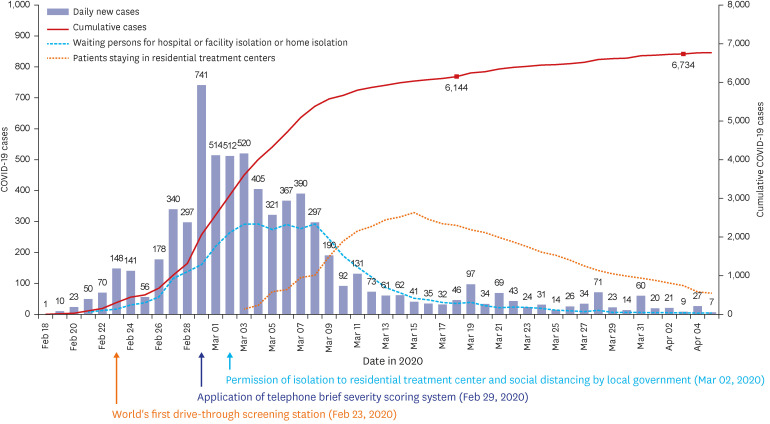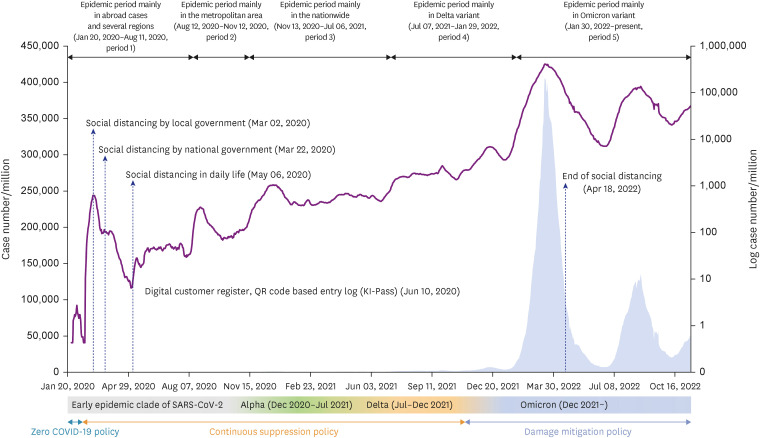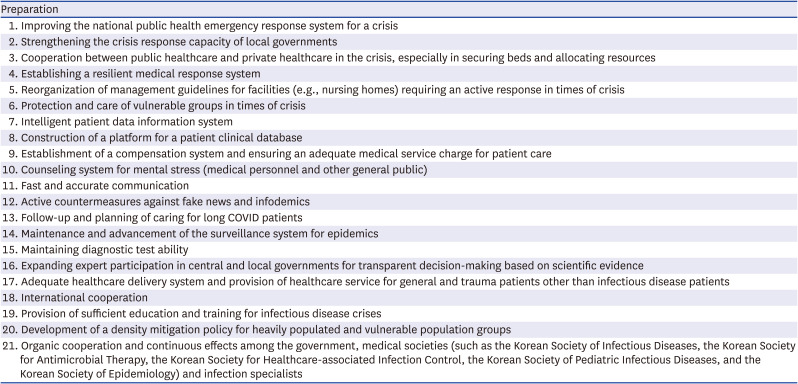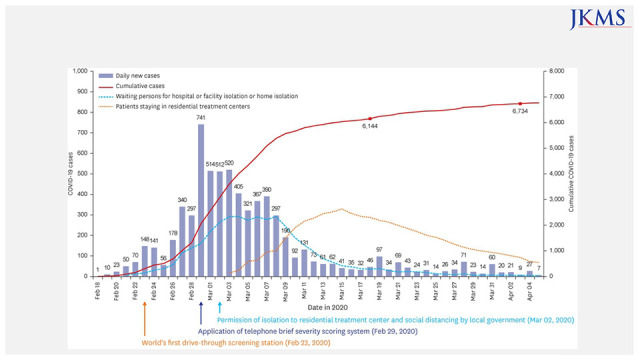1. Korea Disease Control and Prevention Agency. COVID-19 outbreak report from January 20, 2020 to January 19, 2022 in the Republic of Korea. Public Health Wkly Rep. 2022; 15(13):796–805.
2. Korea Disease Control and Prevention Agency. Outbreak report of COVID-19 during designation of class 1 infectious disease in the Republic of Korea (January 20, 2020–April 24, 2022). Public Health Wkly Rep. 2022; 15(30):2126–2136.
3. Kim SW, Kim SM, Kim YK, Kim JY, Lee YM, Kim BO, et al. Clinical characteristics and outcomes of COVID-19 cohort patients in Daegu metropolitan city outbreak in 2020. J Korean Med Sci. 2021; 36(1):e12. PMID:
33398946.
4. Kim JY, Lee YM, Lee H, Kim JW, Kim SW. Epidemiological characteristics of a COVID-19 outbreak caused by religious activities in Daegu, Korea. Epidemiol Health. 2021; 43:e2021024. PMID:
33872485.
5. Korean Society of Infectious Diseases. Korean Society of Pediatric Infectious Diseases. Korean Society of Epidemiology. Korean Society for Antimicrobial Therapy. Korean Society for Healthcare-associated Infection Control and Prevention. Korea Centers for Disease Control and Prevention. Report on the epidemiological features of coronavirus disease 2019 (COVID-19) outbreak in the Republic of Korea from January 19 to March 2, 2020. J Korean Med Sci. 2020; 35(10):e112. PMID:
32174069.
6. Huh K, Shin HS, Peck KR. Emergent strategies for the next phase of COVID-19. Infect Chemother. 2020; 52(1):105–109. PMID:
32100487.
7. Noh JY, Seong H, Yoon JG, Song JY, Cheong HJ, Kim WJ. Social distancing against COVID-19: implication for the control of influenza. J Korean Med Sci. 2020; 35(19):e182. PMID:
32419400.
8. Min KD, Kang H, Lee JY, Jeon S, Cho SI. Estimating the effectiveness of non-pharmaceutical interventions on COVID-19 control in Korea. J Korean Med Sci. 2020; 35(35):e321. PMID:
32893522.
9. Park PG, Kim CH, Heo Y, Kim TS, Park CW, Kim CH. Out-of-hospital cohort treatment of coronavirus disease 2019 patients with mild symptoms in Korea: an experience from a single community treatment center. J Korean Med Sci. 2020; 35(13):e140. PMID:
32242347.
10. Kim SW, Lee KS, Kim K, Lee JJ, Kim JY. Daegu Medical Association. A brief telephone severity scoring system and therapeutic living centers solved acute hospital-bed shortage during the covid-19 outbreak in Daegu, Korea. J Korean Med Sci. 2020; 35(15):e152. PMID:
32301298.
11. Kwon HH, Kim HI, Kwon KT, Hwang S, Kim SW, Kim Y, et al. Healthcare workforce response to the coronavirus disease outbreak in Daegu, Korea: a multi-center, cross-sectional survey. Infect Chemother. 2022; 54(2):298–307. PMID:
35706078.
12. Kim JH, An JAR, Min PK, Bitton A, Gawande AA. How South Korea responded to the Covid-19 outbreak in Daegu. NEJM Catal Innov Care Deliv. 2020; 1(4):04.
13. Choi JY. COVID-19 in South Korea. Postgrad Med J. 2020; 96(1137):399–402. PMID:
32366457.
14. Kwon KT, Ko JH, Shin H, Sung M, Kim JY. Drive-through screening center for COVID-19: A safe and efficient screening system against massive community outbreak. J Korean Med Sci. 2020; 35(11):e123. PMID:
32193904.
15. Lee J. COVID-19 screening center: how to balance between the speed and safety? J Korean Med Sci. 2020; 35(15):e157. PMID:
32301302.
16. Kim SI, Lee JY. Walk-through screening center for COVID-19: an accessible and efficient screening system in a pandemic situation. J Korean Med Sci. 2020; 35(15):e154. PMID:
32301300.
17. Lee Y, Min P, Lee S, Kim SW. Prevalence and duration of acute loss of smell or taste in COVID-19 patients. J Korean Med Sci. 2020; 35(18):e174. PMID:
32383370.
18. Shin HS. Empirical treatment and prevention of COVID-19. Infect Chemother. 2020; 52(2):142–153. PMID:
32476308.
19. Kim SB, Huh K, Heo JY, Joo EJ, Kim YJ, Choi WS, et al. Interim guidelines on antiviral therapy for COVID-19. Infect Chemother. 2020; 52(2):281–304. PMID:
32342676.
20. Hong KS, Jang JG, Hur J, Lee JH, Kim HN, Lee W, et al. Early hydroxychloroquine administration for rapid severe acute respiratory syndrome coronavirus 2 eradication. Infect Chemother. 2020; 52(3):396–402. PMID:
32757497.
21. RECOVERY Collaborative Group. Horby P, Mafham M, Linsell L, Bell JL, Staplin N, et al. Effect of hydroxychloroquine in hospitalized patients with COVID-19. N Engl J Med. 2020; 383(21):2030–2040. PMID:
33031652.
22. Kim SB, Ryoo S, Huh K, Joo EJ, Kim YJ, Choi WS, et al. Revised Korean Society of Infectious Diseases/National Evidence-based Healthcarea Collaborating Agency guidelines on the treatment of patients with COVID-19. Infect Chemother. 2021; 53(1):166–219. PMID:
34409790.
23. RECOVERY Collaborative Group. Lopinavir-ritonavir in patients admitted to hospital with COVID-19 (RECOVERY): a randomised, controlled, open-label, platform trial. Lancet. 2020; 396(10259):1345–1352. PMID:
33031764.
24. Cao B, Wang Y, Wen D, Liu W, Wang J, Fan G, et al. A trial of lopinavir-ritonavir in adults hospitalized with severe COVID-19. N Engl J Med. 2020; 382(19):1787–1799. PMID:
32187464.
25. Park C, Hwang JM, Jo S, Bae SJ, Sakong J. COVID-19 outbreak and its association with healthcare workers’ emotional stress: a cross-sectional study. J Korean Med Sci. 2020; 35(41):e372. PMID:
33107230.
26. Kim B, Kwon KT, Hwang S, Ryoo HW, Chung US, Lee SH, et al. Psychological effects of COVID-19 patient management experience among paramedics and emergency medical technicians: a nationwide survey in Korea. Infect Chemother. 2022; 54(2):316–327. PMID:
35706083.
27. Hyun J, You S, Sohn S, Kim SJ, Bae J, Baik M, et al. Psychosocial support during the COVID-19 outbreak in Korea: activities of multidisciplinary mental health professionals. J Korean Med Sci. 2020; 35(22):e211. PMID:
32508070.
28. RECOVERY Collaborative Group. Horby P, Lim WS, Emberson JR, Mafham M, Bell JL, et al. Dexamethasone in hospitalized patients with Covid-19. N Engl J Med. 2021; 384(8):693–704. PMID:
32678530.
29. Beigel JH, Tomashek KM, Dodd LE, Mehta AK, Zingman BS, Kalil AC, et al. Remdesivir for the treatment of Covid-19 - final report. N Engl J Med. 2020; 383(19):1813–1826. PMID:
32445440.
30. Pawankar R, Thong BY, Tiongco-Recto M, Wang JY, Latiff AH, Leung TF, et al. Asia Pacific perspectives on the second year of the COVID-19 pandemic: a follow-up survey. Clin Exp Allergy. 2022; 52(8):965–973. PMID:
35906963.
31. Joo EJ, Ko JH, Kim SE, Kang SJ, Baek JH, Heo EY, et al. Clinical and virologic effectiveness of remdesivir treatment for severe coronavirus disease 2019 (COVID-19) in Korea: a nationwide multicenter retrospective cohort study. J Korean Med Sci. 2021; 36(11):e83. PMID:
33754512.
32. Kwak YG, Song JE, Kang J, Kang J, Kang HK, Koo HK, et al. Use of the monoclonal antibody regdanvimab to treat patients hospitalized with COVID-19: real-world data during the delta variant predominance. Infect Chemother. 2022; 54:e66.
33. Amano N, Iwata K, Iwata S. Clinical effectiveness of REGN-COV2 in patients with COVID-19 in Japan: a retrospective cohort study with a Bayesian inference. Infect Chemother. 2021; 53(4):767–775. PMID:
34979607.
34. Hong SI, Ryu BH, Hong KW, Bae IG, Cho OH. Real world experience with regdanvimab treatment of mild-to-moderate coronavirus disease-19 in a COVID-19 designated hospital of Korea. Infect Chemother. 2022; 54(1):114–124. PMID:
35384423.
35. Lee CM, Park SW, Lee E. Early oxygen requirement in patients with mild-to-moderate COVID-19 who received regdanvimab after delta-variant outbreak. Infect Chemother. 2022; 54(2):258–265. PMID:
35706081.
36. Planas D, Saunders N, Maes P, Guivel-Benhassine F, Planchais C, Buchrieser J, et al. Considerable escape of SARS-CoV-2 Omicron to antibody neutralization. Nature. 2022; 602(7898):671–675. PMID:
35016199.
37. Kim HM, Kwon KT, Cha HH, Seong WJ, Kim MJ. Prediction of adverse outcomes among women in the third trimester of pregnancy with coronavirus disease 2019. Infect Chemother. 2022; 54(3):493–503. PMID:
36196608.
38. Park HC, Lee YK, Ko E, Yu S, Cho A, Kim DH, et al. COVID-19-related clinical outcomes among Korean hemodialysis patients. Kidney Res Clin Pract. 2022; 41(5):591–600. PMID:
35791744.
39. Lim JH, Park SH, Jeon Y, Cho JH, Jung HY, Choi JY, et al. Fatal outcomes of COVID-19 in patients with severe acute kidney injury. J Clin Med. 2020; 9(6):1718. PMID:
32503180.
40. Choi JH, Choi SH, Yun KW. Risk factors for severe COVID-19 in children: A systematic review and meta-analysis. J Korean Med Sci. 2022; 37(5):e35. PMID:
35132841.
41. Hong SH, Shi HJ, Kim SY, Park Y, Eom JS. Clinical characteristics and pregnancy-related outcomes of pregnant women hospitalized with COVID-19 during the delta wave: a single-center observational study. Infect Chemother. 2022; 54(3):433–445. PMID:
35920268.
42. Park JJ, Seo YB, Lee J, Na SH, Choi YK. Protocol and clinical characteristics of patients under ‘at-home care’ for COVID-19 in South Korea: a retrospective cohort study. BMJ Open. 2022; 12(6):e061765.
43. Gu H, Krishnan P, Ng DY, Chang LD, Liu GY, Cheng SS, et al. Probable transmission of SARS-CoV-2 omicron variant in quarantine hotel, Hong Kong, China, November 2021. Emerg Infect Dis. 2022; 28(2):460–462. PMID:
34860154.
44. Ji S, Xiao S, Wang H, Lei H. Increasing contributions of airborne route in SARS-CoV-2 omicron variant transmission compared with the ancestral strain. Build Environ. 2022; 221:109328. PMID:
35784591.
45. Song JY, Peck KR. Korean Society of Infectious Diseases. A debate on public health responses to COVID-19: focused protection versus sustained suppression. J Korean Med Sci. 2020; 35(49):e433. PMID:
33350189.
46. Jung J. Preparing for the coronavirus disease (COVID-19) vaccination: evidence, plans, and implications. J Korean Med Sci. 2021; 36(7):e59. PMID:
33619920.
47. Kwon SL, Oh J. COVID-19 vaccination program in South Korea: a long journey toward a new normal. Health Policy Technol. 2022; 11(2):100601. PMID:
35127400.
48. Kang SJ, Jung SI. Age-related morbidity and mortality among patients with COVID-19. Infect Chemother. 2020; 52(2):154–164. PMID:
32537961.
49. Kim M, Yoo JR, Heo ST, Lee HR, Oh H. Clinical characteristics and risk factors for severe disease of coronavirus disease 2019 in a low case fatality rate region in Korea. Infect Chemother. 2021; 53(4):718–729. PMID:
34951535.
50. Kang E, Lee SY, Kim MS, Jung H, Kim KH, Kim KN, et al. The psychological burden of COVID-19 stigma: evaluation of the mental health of isolated mild condition covid-19 patients. J Korean Med Sci. 2021; 36(3):e33. PMID:
33463098.
51. Hoang T, Tran Thi Anh T. Comparison of comorbidities in relation to critical conditions among coronavirus disease 2019 patients: a network meta-analysis. Infect Chemother. 2021; 53(1):13–28. PMID:
34409779.
52. Ji W, Huh K, Kang M, Hong J, Bae GH, Lee R, et al. Effect of underlying comorbidities on the infection and severity of COVID-19 in Korea: a nationwide case-control study. J Korean Med Sci. 2020; 35(25):e237. PMID:
32597048.
53. Suh HJ, Kim DH, Heo EY, Lee HW, Lee JK, Lee CS, et al. Clinical characteristics of COVID-19: clinical dynamics of mild severe acute respiratory syndrome coronavirus 2 infection detected by early active surveillance. J Korean Med Sci. 2020; 35(32):e297. PMID:
32808513.
54. Hastie CE, Lowe DJ, McAuley A, Winter AJ, Mills NL, Black C, et al. Outcomes among confirmed cases and a matched comparison group in the Long-COVID in Scotland study. Nat Commun. 2022; 13(1):5663. PMID:
36224173.
55. Song JE, Oh GB, Park HK, Lee SS, Kwak YG. Survey of adverse events after the first dose of the ChAdOx1 nCoV-19 vaccine: a single-center experience in Korea. Infect Chemother. 2021; 53(3):557–561. PMID:
34405593.
56. Shang W, Wang Y, Yuan J, Guo Z, Liu J, Liu M. Global excess mortality during COVID-19 pandemic: a systematic review and meta-analysis. Vaccines (Basel). 2022; 10(10):1702. PMID:
36298567.
57. Yoo SH, Sim JA, Shin J, Keam B, Park JB, Shin A. The impact of COVID-19 on cancer care in a tertiary hospital in Korea: possible collateral damage to emergency care. Epidemiol Health. 2022; 44:e2022044. PMID:
35538696.
58. Yang HJ, Yoon H, Kang SY, Lee G, Park JE, Kim T, et al. Respiratory protection effect of ear-loop-type KF94 masks according to the wearing method in COVID-19 pandemic: a randomized, open-label study. J Korean Med Sci. 2021; 36(28):e209. PMID:
34282608.
59. Li T, Liu Y, Li M, Qian X, Dai SY. Mask or no mask for COVID-19: a public health and market study. PLoS One. 2020; 15(8):e0237691. PMID:
32797067.
60. Lee SH, Noh JW, Kim Y, Ryoo HW, Park KH, Park SY, et al. Expert consensus on measures to promote physical and psychological health among COVID-19-related healthcare workers in Korea using Delphi technique. Infect Chemother. 2022; 54(2):247–257. PMID:
35706073.
61. Gupta L, Gasparyan AY, Misra DP, Agarwal V, Zimba O, Yessirkepov M. Information and misinformation on COVID-19: a cross-sectional survey study. J Korean Med Sci. 2020; 35(27):e256. PMID:
32657090.
62. Jung J. A long way to the recovery: COVID-19 will not disappear. J Korean Med Sci. 2021; 36(32):e231. PMID:
34402229.
63. Kim J, Ashihara K. National disaster management system: COVID-19 case in Korea. Int J Environ Res Public Health. 2020; 17(18):6691. PMID:
32937946.
64. Wernli D, Clausin M, Antulov-Fantulin N, Berezowski J, Biller-Andorno N, Blanchet K, et al. Building a multisystemic understanding of societal resilience to the COVID-19 pandemic. BMJ Glob Health. 2021; 6(7):e006794.
65. Haldane V, De Foo C, Abdalla SM, Jung AS, Tan M, Wu S, et al. Health systems resilience in managing the COVID-19 pandemic: lessons from 28 countries. Nat Med. 2021; 27(6):964–980. PMID:
34002090.
66. Lim S. The COVID-19 pandemic battlefield: protection of long term care hospitals. Infect Chemother. 2020; 52(2):231–233. PMID:
32618148.
67. Yoon YK, Lee J, Kim SI, Peck KR. A systematic narrative review of comprehensive preparedness strategies of healthcare resources for a large resurgence of COVID-19 nationally, with local or regional epidemics: present era and beyond. J Korean Med Sci. 2020; 35(44):e387. PMID:
33200593.
68. Kim Y, Bitna-Ha , Kim SW, Chang HH, Kwon KT, Bae S, et al. Post-acute COVID-19 syndrome in patients after 12 months from COVID-19 infection in Korea. BMC Infect Dis. 2022; 22(1):93. PMID:
35086489.
69. Kim Y, Kim SE, Kim T, Yun KW, Lee SH, Lee E, et al. Preliminary guidelines for the clinical evaluation and management of long COVID. Infect Chemother. 2022; 54(3):566–597. PMID:
36196612.
70. Giri S, Chenn LM, Romero-Ortuno R. Nursing homes during the COVID-19 pandemic: a scoping review of challenges and responses. Eur Geriatr Med. 2021; 12(6):1127–1136. PMID:
34136990.
71. Kim CO, Jang SN. Who are the people willing to pay for physician home visits? J Korean Med Sci. 2020; 35(20):e158. PMID:
32449323.
72. You J. Lessons from South Korea’s Covid-19 policy response. Am Rev Public Adm. 2020; 50(6-7):801–808.
73. Kim Y, Kim SW, Chang HH, Kwon KT, Bae S, Hwang S. Significance and associated factors of long-term sequelae in patients after acute COVID-19 infection in Korea. Infect Chemother. 2021; 53(3):463–476. PMID:
34405592.
74. Kim Y, Kim SW, Chang HH, Kwon KT, Hwang S, Bae S. One year follow-up of COVID-19 related symptoms and patient quality of life: a prospective cohort study. Yonsei Med J. 2022; 63(6):499–510. PMID:
35619573.
75. Morens DM, Breman JG, Calisher CH, Doherty PC, Hahn BH, Keusch GT, et al. The origin of COVID-19 and why it matters. Am J Trop Med Hyg. 2020; 103(3):955–959. PMID:
32700664.
76. Simpson S, Kaufmann MC, Glozman V, Chakrabarti A. Disease X: accelerating the development of medical countermeasures for the next pandemic. Lancet Infect Dis. 2020; 20(5):e108–e115. PMID:
32197097.








 PDF
PDF Citation
Citation Print
Print




 XML Download
XML Download